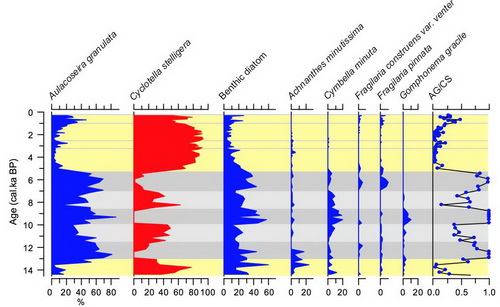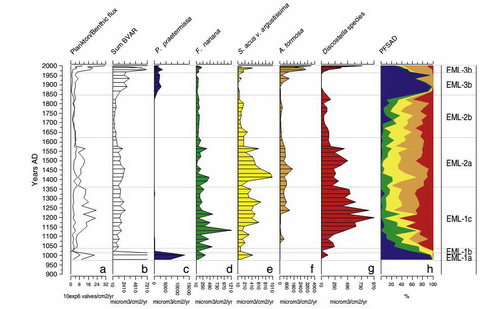Diatoms are a kind of single-cell microalgae with a siliceous frustule ranging from 2μm to 5mm. Diatoms are widely distributed in various aquatic environments and are partitioned into benthic, epiphytic and planktonic species according to the differences in physiological habits.
Diatoms can provide high-resolution information on the changes of paleo-environments mainly due to their general classification to species, their sensitive responses to the changes of aquatic environments and well preservations in the sediments. Therefore, they are generally regarded as an appropriate biological index in the Quaternary research.
We focus on the reconstruction of climatic and environmental changes of Chinese lakes using sub-fossil diatom records. The main areas of our work include Huguang Maar Lake in Guangdong Province, Yunlong Lake in Yunnan Province and other lakes in Inner Mongolia and Northeast of China. A series of academic achievements in recent years are listed as follows:
1. A new index of the East Asian Winter Monsoon (EAWM) is developed. The changes of the EAWM in the past 15,000 years indicated by diatoms show the weakening tendency of EAWM from the early Holocene to the late Holocene (Fig. 1);
2. The seasonality of global warming effect is discussed. We conclude that the Medieval Warm Period (MWP) is warmer than now as the length of summer of the MWP is longer than the 20th century (Fig. 2);
3. The inner links between algae communities and organic carbon isotopes is tracked. By comparing diatom records and variations of organic carbon isotopes from Erlongwan Maar Lake (Fig. 3), we conclude that the ratios of the benthic to planktonic diatoms play an important role in the lacustrine organic carbon isotopes.

Fig.1. Changes of EAWM in the past 15,000 years indicated by diatoms in Huguang Maar Lake.

Fig.2. Diatom assemblage changes in the past 1,000 years from Erlongwan Maar Lake.
a. Planktonic and benthic diatom flux in the EML sediment record. b. Total diatom biovolume accumulation rate (BVAR). c–g. Variation in BVAR for the main diatom species(note the different scales on the x-axis). h. Contribution in terms of relative percentages to the total BVAR of the main diatom species.

Fig.3. a. δ13C; b. ratio of planktonic to benthic diatoms from Erlongwan Maar Lake.





